Financial Management Report: Sainsbury's Financial Analysis
VerifiedAdded on 2023/01/13
|12
|3057
|30
Report
AI Summary
This report provides a comprehensive analysis of financial management within Sainsbury's, focusing on key areas such as strategic planning, decision-making, and financial sustainability. It begins with an introduction to financial management principles and their application within the company, followed by an overview of how data and information are utilized in strategic and operational decisions. The report then delves into investment appraisal techniques, comparing and contrasting methods like payback period, ARR, and NPV, evaluating their effectiveness in maximizing returns. The importance of various accounting techniques, including income statements, cash flow statements, and break-even analysis, in the decision-making process is also examined. Furthermore, the report analyzes Sainsbury's financial decision-making in relation to long-term business sustainability, supported by a detailed ratio analysis covering profitability, liquidity, efficiency, and gearing ratios. Finally, it explores the role of management accounting in improving financial sustainability, including techniques like activity-based costing. This report, available on Desklib, offers insights into financial management practices and their impact on business performance.
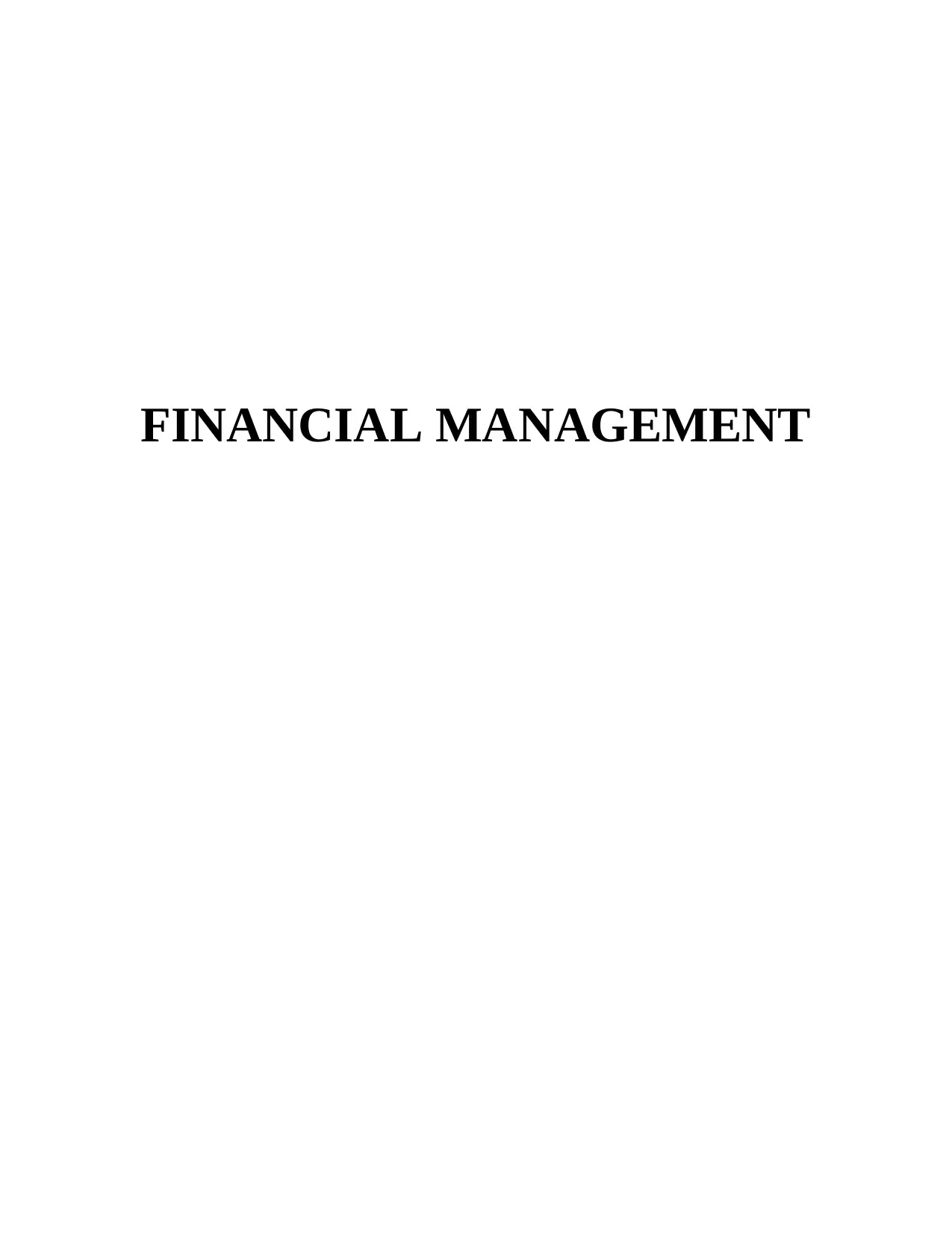
FINANCIAL MANAGEMENT
Paraphrase This Document
Need a fresh take? Get an instant paraphrase of this document with our AI Paraphraser
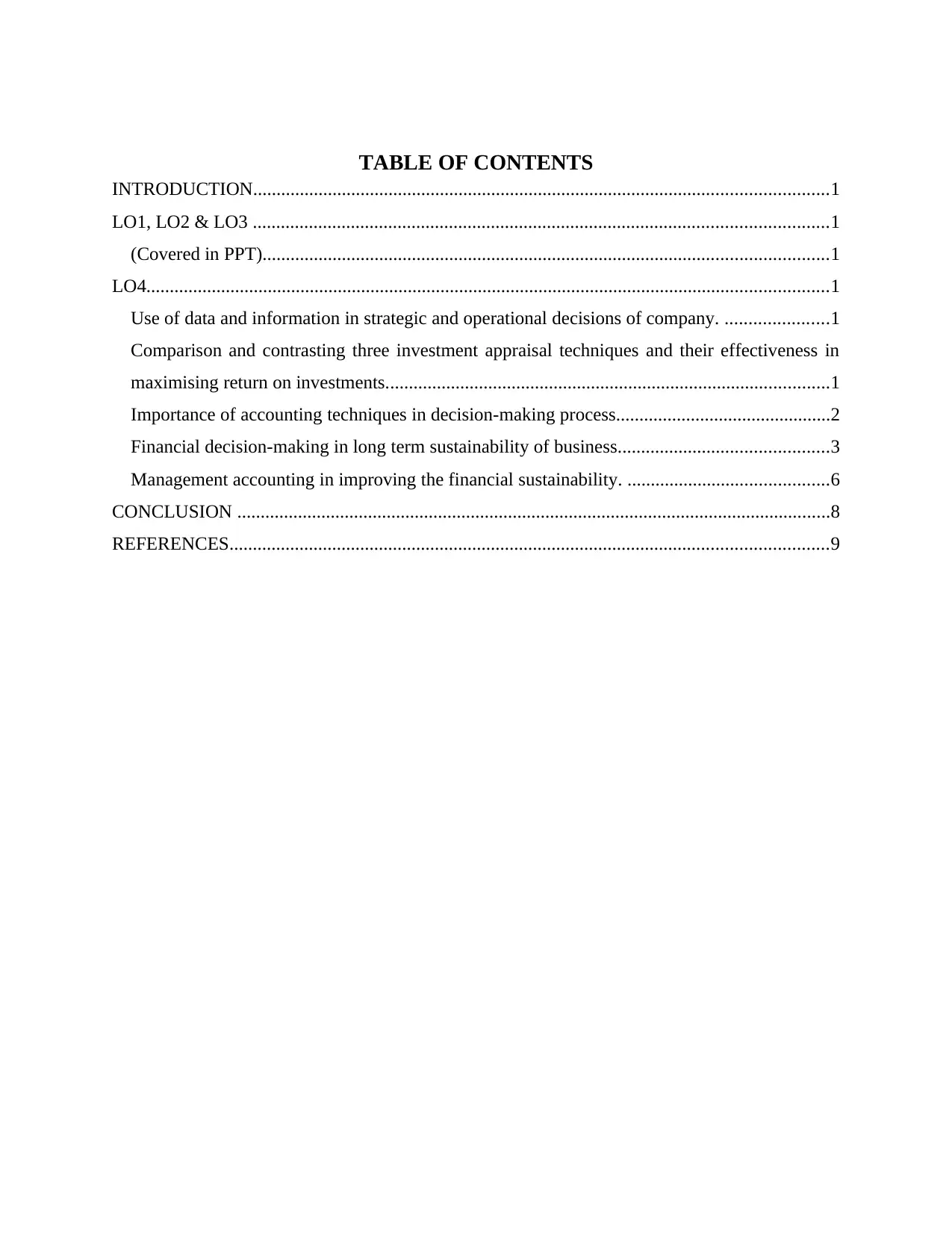
TABLE OF CONTENTS
INTRODUCTION...........................................................................................................................1
LO1, LO2 & LO3 ...........................................................................................................................1
(Covered in PPT).........................................................................................................................1
LO4..................................................................................................................................................1
Use of data and information in strategic and operational decisions of company. ......................1
Comparison and contrasting three investment appraisal techniques and their effectiveness in
maximising return on investments...............................................................................................1
Importance of accounting techniques in decision-making process..............................................2
Financial decision-making in long term sustainability of business.............................................3
Management accounting in improving the financial sustainability. ...........................................6
CONCLUSION ...............................................................................................................................8
REFERENCES................................................................................................................................9
INTRODUCTION...........................................................................................................................1
LO1, LO2 & LO3 ...........................................................................................................................1
(Covered in PPT).........................................................................................................................1
LO4..................................................................................................................................................1
Use of data and information in strategic and operational decisions of company. ......................1
Comparison and contrasting three investment appraisal techniques and their effectiveness in
maximising return on investments...............................................................................................1
Importance of accounting techniques in decision-making process..............................................2
Financial decision-making in long term sustainability of business.............................................3
Management accounting in improving the financial sustainability. ...........................................6
CONCLUSION ...............................................................................................................................8
REFERENCES................................................................................................................................9
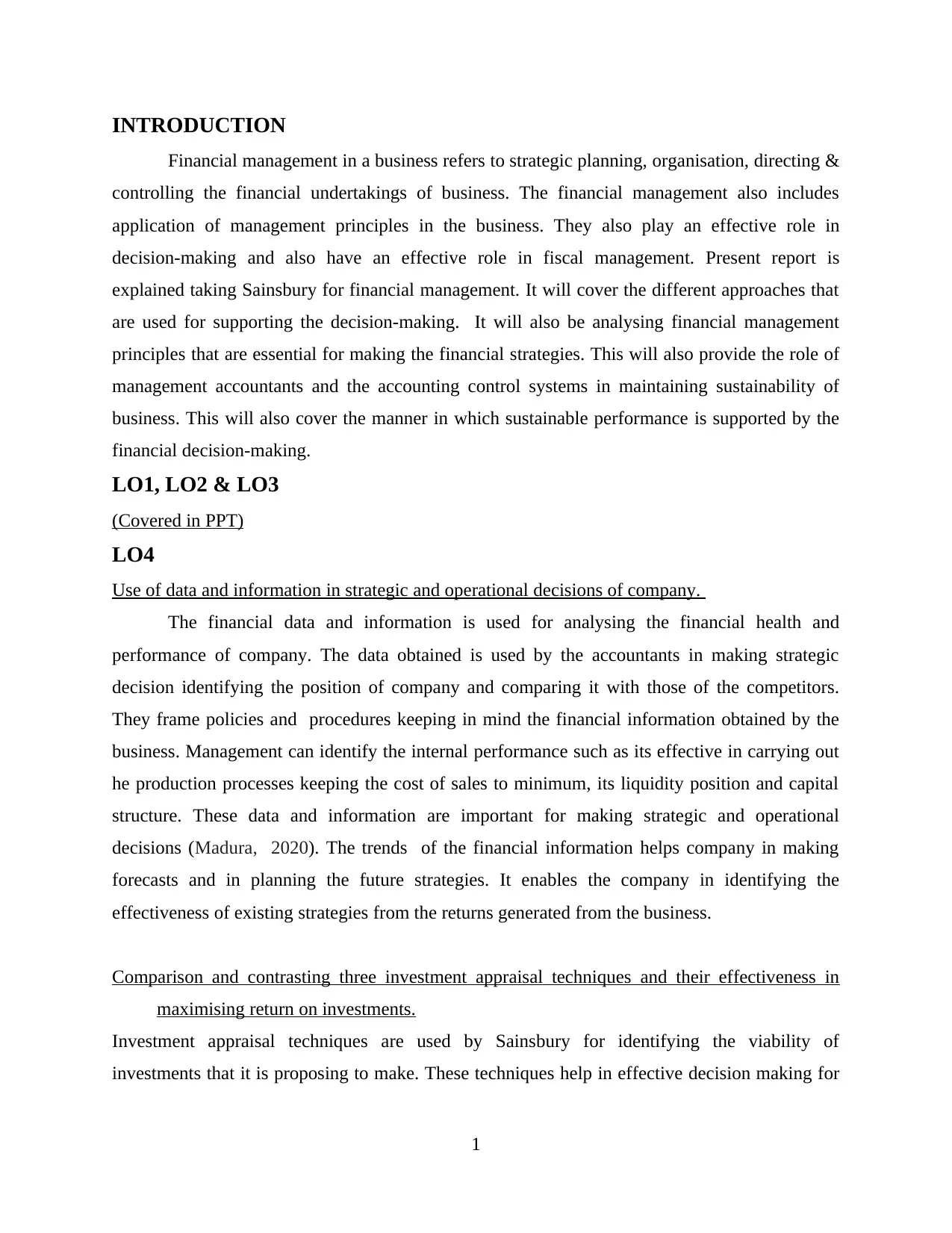
INTRODUCTION
Financial management in a business refers to strategic planning, organisation, directing &
controlling the financial undertakings of business. The financial management also includes
application of management principles in the business. They also play an effective role in
decision-making and also have an effective role in fiscal management. Present report is
explained taking Sainsbury for financial management. It will cover the different approaches that
are used for supporting the decision-making. It will also be analysing financial management
principles that are essential for making the financial strategies. This will also provide the role of
management accountants and the accounting control systems in maintaining sustainability of
business. This will also cover the manner in which sustainable performance is supported by the
financial decision-making.
LO1, LO2 & LO3
(Covered in PPT)
LO4
Use of data and information in strategic and operational decisions of company.
The financial data and information is used for analysing the financial health and
performance of company. The data obtained is used by the accountants in making strategic
decision identifying the position of company and comparing it with those of the competitors.
They frame policies and procedures keeping in mind the financial information obtained by the
business. Management can identify the internal performance such as its effective in carrying out
he production processes keeping the cost of sales to minimum, its liquidity position and capital
structure. These data and information are important for making strategic and operational
decisions (Madura, 2020). The trends of the financial information helps company in making
forecasts and in planning the future strategies. It enables the company in identifying the
effectiveness of existing strategies from the returns generated from the business.
Comparison and contrasting three investment appraisal techniques and their effectiveness in
maximising return on investments.
Investment appraisal techniques are used by Sainsbury for identifying the viability of
investments that it is proposing to make. These techniques help in effective decision making for
1
Financial management in a business refers to strategic planning, organisation, directing &
controlling the financial undertakings of business. The financial management also includes
application of management principles in the business. They also play an effective role in
decision-making and also have an effective role in fiscal management. Present report is
explained taking Sainsbury for financial management. It will cover the different approaches that
are used for supporting the decision-making. It will also be analysing financial management
principles that are essential for making the financial strategies. This will also provide the role of
management accountants and the accounting control systems in maintaining sustainability of
business. This will also cover the manner in which sustainable performance is supported by the
financial decision-making.
LO1, LO2 & LO3
(Covered in PPT)
LO4
Use of data and information in strategic and operational decisions of company.
The financial data and information is used for analysing the financial health and
performance of company. The data obtained is used by the accountants in making strategic
decision identifying the position of company and comparing it with those of the competitors.
They frame policies and procedures keeping in mind the financial information obtained by the
business. Management can identify the internal performance such as its effective in carrying out
he production processes keeping the cost of sales to minimum, its liquidity position and capital
structure. These data and information are important for making strategic and operational
decisions (Madura, 2020). The trends of the financial information helps company in making
forecasts and in planning the future strategies. It enables the company in identifying the
effectiveness of existing strategies from the returns generated from the business.
Comparison and contrasting three investment appraisal techniques and their effectiveness in
maximising return on investments.
Investment appraisal techniques are used by Sainsbury for identifying the viability of
investments that it is proposing to make. These techniques help in effective decision making for
1
⊘ This is a preview!⊘
Do you want full access?
Subscribe today to unlock all pages.

Trusted by 1+ million students worldwide
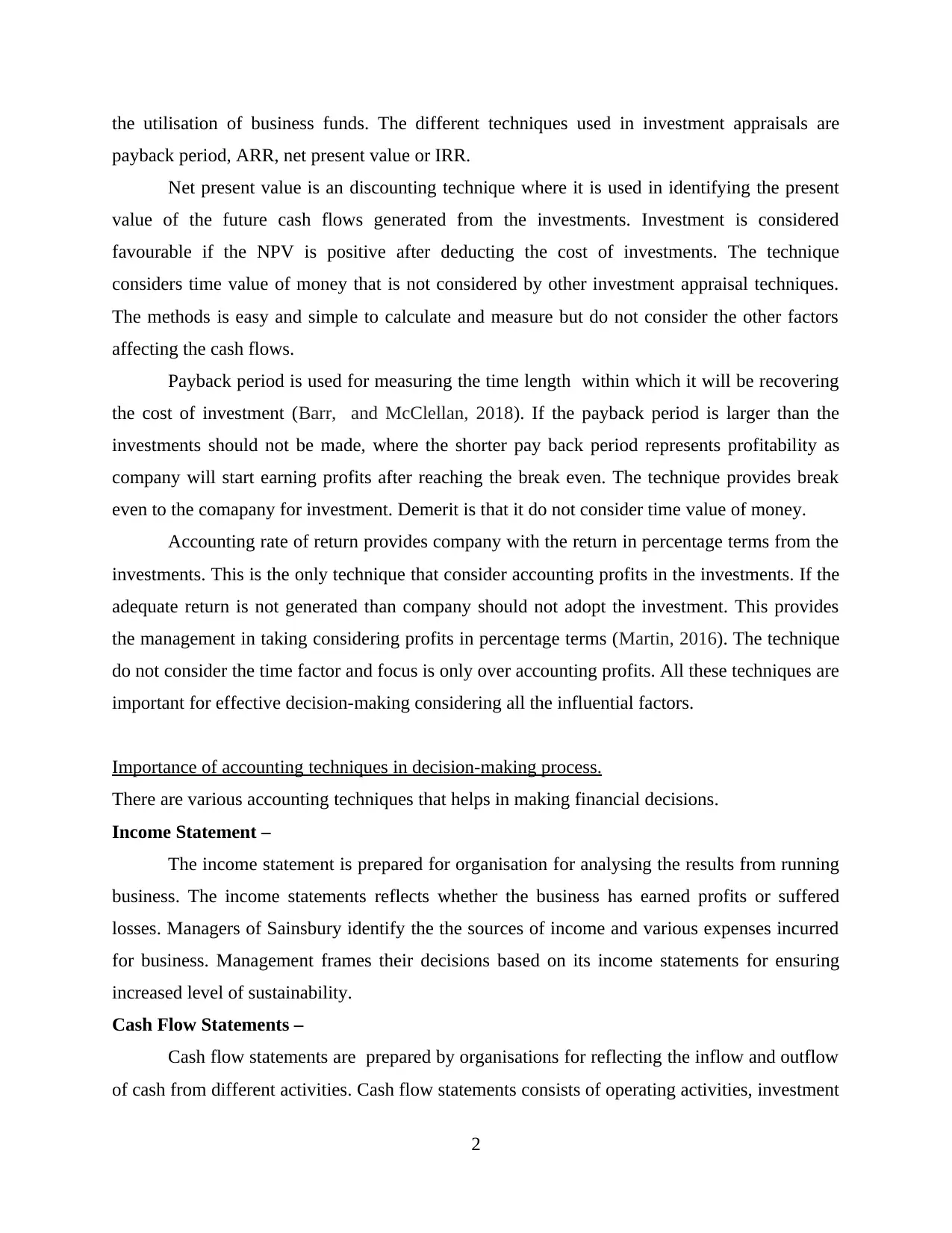
the utilisation of business funds. The different techniques used in investment appraisals are
payback period, ARR, net present value or IRR.
Net present value is an discounting technique where it is used in identifying the present
value of the future cash flows generated from the investments. Investment is considered
favourable if the NPV is positive after deducting the cost of investments. The technique
considers time value of money that is not considered by other investment appraisal techniques.
The methods is easy and simple to calculate and measure but do not consider the other factors
affecting the cash flows.
Payback period is used for measuring the time length within which it will be recovering
the cost of investment (Barr, and McClellan, 2018). If the payback period is larger than the
investments should not be made, where the shorter pay back period represents profitability as
company will start earning profits after reaching the break even. The technique provides break
even to the comapany for investment. Demerit is that it do not consider time value of money.
Accounting rate of return provides company with the return in percentage terms from the
investments. This is the only technique that consider accounting profits in the investments. If the
adequate return is not generated than company should not adopt the investment. This provides
the management in taking considering profits in percentage terms (Martin, 2016). The technique
do not consider the time factor and focus is only over accounting profits. All these techniques are
important for effective decision-making considering all the influential factors.
Importance of accounting techniques in decision-making process.
There are various accounting techniques that helps in making financial decisions.
Income Statement –
The income statement is prepared for organisation for analysing the results from running
business. The income statements reflects whether the business has earned profits or suffered
losses. Managers of Sainsbury identify the the sources of income and various expenses incurred
for business. Management frames their decisions based on its income statements for ensuring
increased level of sustainability.
Cash Flow Statements –
Cash flow statements are prepared by organisations for reflecting the inflow and outflow
of cash from different activities. Cash flow statements consists of operating activities, investment
2
payback period, ARR, net present value or IRR.
Net present value is an discounting technique where it is used in identifying the present
value of the future cash flows generated from the investments. Investment is considered
favourable if the NPV is positive after deducting the cost of investments. The technique
considers time value of money that is not considered by other investment appraisal techniques.
The methods is easy and simple to calculate and measure but do not consider the other factors
affecting the cash flows.
Payback period is used for measuring the time length within which it will be recovering
the cost of investment (Barr, and McClellan, 2018). If the payback period is larger than the
investments should not be made, where the shorter pay back period represents profitability as
company will start earning profits after reaching the break even. The technique provides break
even to the comapany for investment. Demerit is that it do not consider time value of money.
Accounting rate of return provides company with the return in percentage terms from the
investments. This is the only technique that consider accounting profits in the investments. If the
adequate return is not generated than company should not adopt the investment. This provides
the management in taking considering profits in percentage terms (Martin, 2016). The technique
do not consider the time factor and focus is only over accounting profits. All these techniques are
important for effective decision-making considering all the influential factors.
Importance of accounting techniques in decision-making process.
There are various accounting techniques that helps in making financial decisions.
Income Statement –
The income statement is prepared for organisation for analysing the results from running
business. The income statements reflects whether the business has earned profits or suffered
losses. Managers of Sainsbury identify the the sources of income and various expenses incurred
for business. Management frames their decisions based on its income statements for ensuring
increased level of sustainability.
Cash Flow Statements –
Cash flow statements are prepared by organisations for reflecting the inflow and outflow
of cash from different activities. Cash flow statements consists of operating activities, investment
2
Paraphrase This Document
Need a fresh take? Get an instant paraphrase of this document with our AI Paraphraser
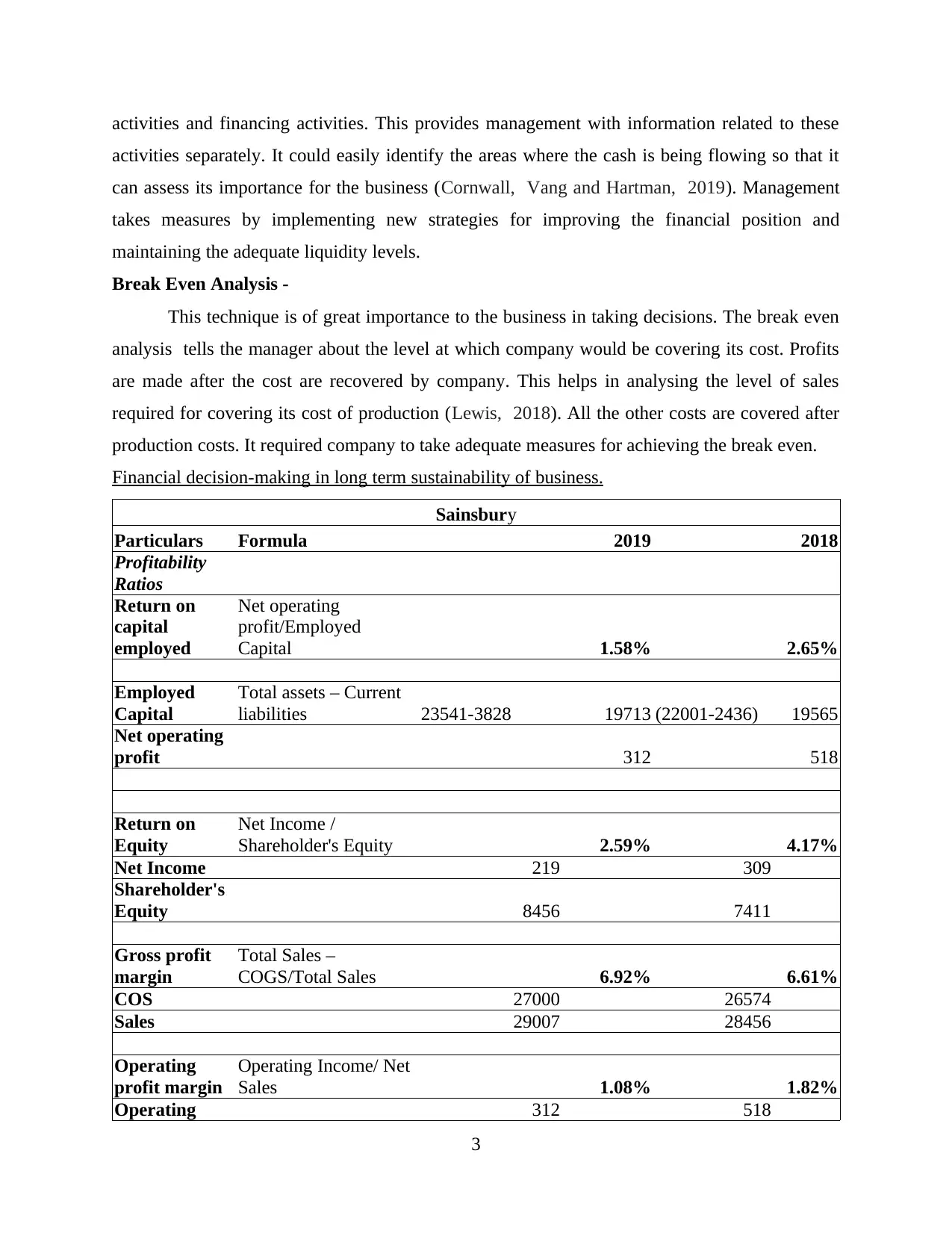
activities and financing activities. This provides management with information related to these
activities separately. It could easily identify the areas where the cash is being flowing so that it
can assess its importance for the business (Cornwall, Vang and Hartman, 2019). Management
takes measures by implementing new strategies for improving the financial position and
maintaining the adequate liquidity levels.
Break Even Analysis -
This technique is of great importance to the business in taking decisions. The break even
analysis tells the manager about the level at which company would be covering its cost. Profits
are made after the cost are recovered by company. This helps in analysing the level of sales
required for covering its cost of production (Lewis, 2018). All the other costs are covered after
production costs. It required company to take adequate measures for achieving the break even.
Financial decision-making in long term sustainability of business.
Sainsbury
Particulars Formula 2019 2018
Profitability
Ratios
Return on
capital
employed
Net operating
profit/Employed
Capital 1.58% 2.65%
Employed
Capital
Total assets – Current
liabilities 23541-3828 19713 (22001-2436) 19565
Net operating
profit 312 518
Return on
Equity
Net Income /
Shareholder's Equity 2.59% 4.17%
Net Income 219 309
Shareholder's
Equity 8456 7411
Gross profit
margin
Total Sales –
COGS/Total Sales 6.92% 6.61%
COS 27000 26574
Sales 29007 28456
Operating
profit margin
Operating Income/ Net
Sales 1.08% 1.82%
Operating 312 518
3
activities separately. It could easily identify the areas where the cash is being flowing so that it
can assess its importance for the business (Cornwall, Vang and Hartman, 2019). Management
takes measures by implementing new strategies for improving the financial position and
maintaining the adequate liquidity levels.
Break Even Analysis -
This technique is of great importance to the business in taking decisions. The break even
analysis tells the manager about the level at which company would be covering its cost. Profits
are made after the cost are recovered by company. This helps in analysing the level of sales
required for covering its cost of production (Lewis, 2018). All the other costs are covered after
production costs. It required company to take adequate measures for achieving the break even.
Financial decision-making in long term sustainability of business.
Sainsbury
Particulars Formula 2019 2018
Profitability
Ratios
Return on
capital
employed
Net operating
profit/Employed
Capital 1.58% 2.65%
Employed
Capital
Total assets – Current
liabilities 23541-3828 19713 (22001-2436) 19565
Net operating
profit 312 518
Return on
Equity
Net Income /
Shareholder's Equity 2.59% 4.17%
Net Income 219 309
Shareholder's
Equity 8456 7411
Gross profit
margin
Total Sales –
COGS/Total Sales 6.92% 6.61%
COS 27000 26574
Sales 29007 28456
Operating
profit margin
Operating Income/ Net
Sales 1.08% 1.82%
Operating 312 518
3

income
Revenues 29007 28456
Assets
Turnover Sales / Net assets 123.22%
129.34
%
Sales 29007 28456
Net assets 23541 22001
Liquidity
Ratios
Current assets 7589 7866
Current
liabilities 11417 10302
Inventory 1929 1810
Quick assets 5660 6056
Current ratio
Current assets / current
liabilities 0.66 0.76
Quick ratio
Current assets - (stock
+ prepaid expenses) 0.50 0.59
Efficiency
Ratios
Inventory 1929 1810
Trade
Receivables 144 117
Trade
Payables 3044 2852
Days 365 365
COS 27000 26574
Sales 29007 28456
Inventory
days Inventory/COS*365 26.077 24.861
Debtor days Debtor/ Sales*365 1.81 1.50
Creditor days Creditor / Sales*365 38.30 36.58
Gearing Ratio
Long-term debt 1003 1505
Shareholder's
equity 8456 7411
Debt-equity
ratio 0.12 0.20
4
Revenues 29007 28456
Assets
Turnover Sales / Net assets 123.22%
129.34
%
Sales 29007 28456
Net assets 23541 22001
Liquidity
Ratios
Current assets 7589 7866
Current
liabilities 11417 10302
Inventory 1929 1810
Quick assets 5660 6056
Current ratio
Current assets / current
liabilities 0.66 0.76
Quick ratio
Current assets - (stock
+ prepaid expenses) 0.50 0.59
Efficiency
Ratios
Inventory 1929 1810
Trade
Receivables 144 117
Trade
Payables 3044 2852
Days 365 365
COS 27000 26574
Sales 29007 28456
Inventory
days Inventory/COS*365 26.077 24.861
Debtor days Debtor/ Sales*365 1.81 1.50
Creditor days Creditor / Sales*365 38.30 36.58
Gearing Ratio
Long-term debt 1003 1505
Shareholder's
equity 8456 7411
Debt-equity
ratio 0.12 0.20
4
⊘ This is a preview!⊘
Do you want full access?
Subscribe today to unlock all pages.

Trusted by 1+ million students worldwide
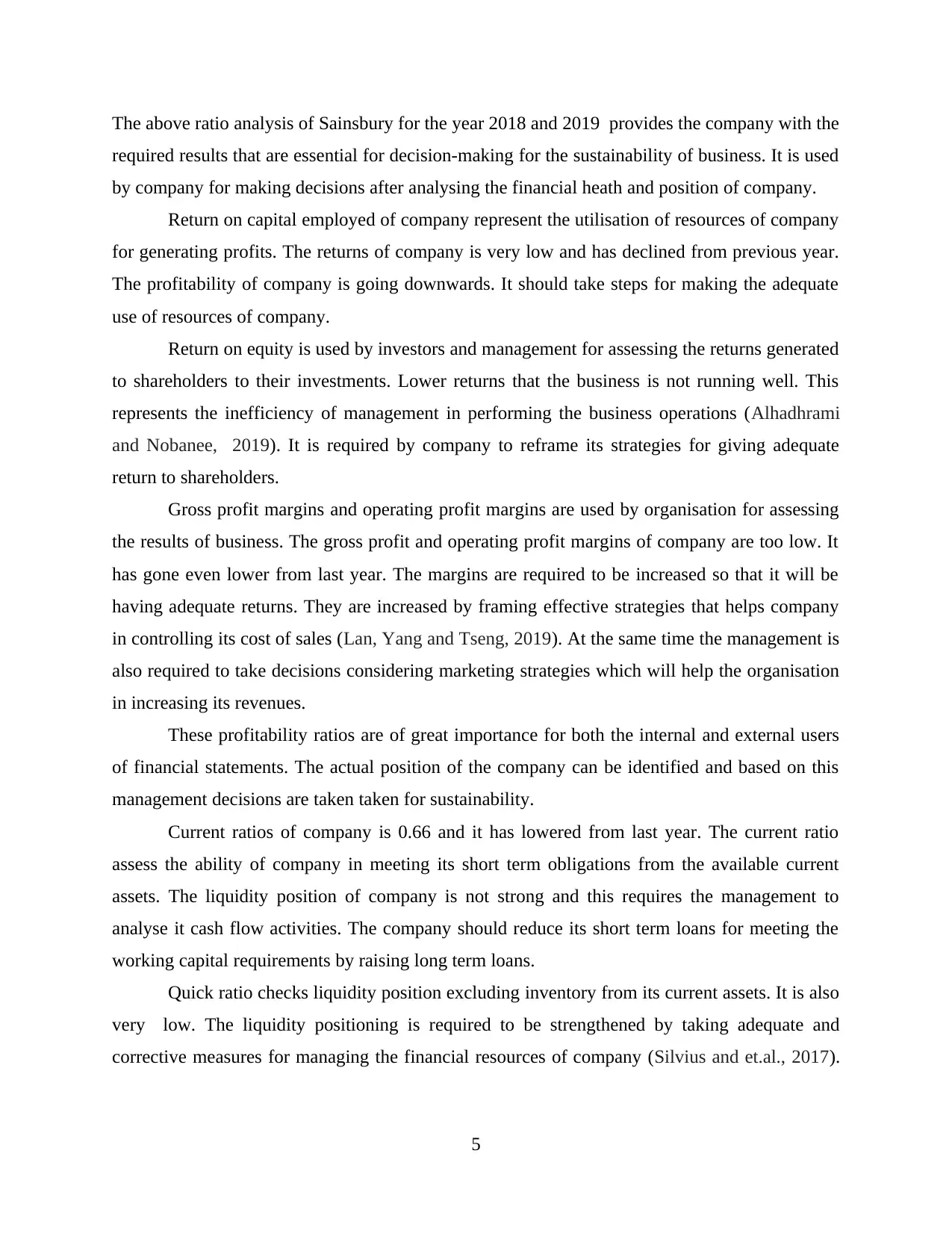
The above ratio analysis of Sainsbury for the year 2018 and 2019 provides the company with the
required results that are essential for decision-making for the sustainability of business. It is used
by company for making decisions after analysing the financial heath and position of company.
Return on capital employed of company represent the utilisation of resources of company
for generating profits. The returns of company is very low and has declined from previous year.
The profitability of company is going downwards. It should take steps for making the adequate
use of resources of company.
Return on equity is used by investors and management for assessing the returns generated
to shareholders to their investments. Lower returns that the business is not running well. This
represents the inefficiency of management in performing the business operations (Alhadhrami
and Nobanee, 2019). It is required by company to reframe its strategies for giving adequate
return to shareholders.
Gross profit margins and operating profit margins are used by organisation for assessing
the results of business. The gross profit and operating profit margins of company are too low. It
has gone even lower from last year. The margins are required to be increased so that it will be
having adequate returns. They are increased by framing effective strategies that helps company
in controlling its cost of sales (Lan, Yang and Tseng, 2019). At the same time the management is
also required to take decisions considering marketing strategies which will help the organisation
in increasing its revenues.
These profitability ratios are of great importance for both the internal and external users
of financial statements. The actual position of the company can be identified and based on this
management decisions are taken taken for sustainability.
Current ratios of company is 0.66 and it has lowered from last year. The current ratio
assess the ability of company in meeting its short term obligations from the available current
assets. The liquidity position of company is not strong and this requires the management to
analyse it cash flow activities. The company should reduce its short term loans for meeting the
working capital requirements by raising long term loans.
Quick ratio checks liquidity position excluding inventory from its current assets. It is also
very low. The liquidity positioning is required to be strengthened by taking adequate and
corrective measures for managing the financial resources of company (Silvius and et.al., 2017).
5
required results that are essential for decision-making for the sustainability of business. It is used
by company for making decisions after analysing the financial heath and position of company.
Return on capital employed of company represent the utilisation of resources of company
for generating profits. The returns of company is very low and has declined from previous year.
The profitability of company is going downwards. It should take steps for making the adequate
use of resources of company.
Return on equity is used by investors and management for assessing the returns generated
to shareholders to their investments. Lower returns that the business is not running well. This
represents the inefficiency of management in performing the business operations (Alhadhrami
and Nobanee, 2019). It is required by company to reframe its strategies for giving adequate
return to shareholders.
Gross profit margins and operating profit margins are used by organisation for assessing
the results of business. The gross profit and operating profit margins of company are too low. It
has gone even lower from last year. The margins are required to be increased so that it will be
having adequate returns. They are increased by framing effective strategies that helps company
in controlling its cost of sales (Lan, Yang and Tseng, 2019). At the same time the management is
also required to take decisions considering marketing strategies which will help the organisation
in increasing its revenues.
These profitability ratios are of great importance for both the internal and external users
of financial statements. The actual position of the company can be identified and based on this
management decisions are taken taken for sustainability.
Current ratios of company is 0.66 and it has lowered from last year. The current ratio
assess the ability of company in meeting its short term obligations from the available current
assets. The liquidity position of company is not strong and this requires the management to
analyse it cash flow activities. The company should reduce its short term loans for meeting the
working capital requirements by raising long term loans.
Quick ratio checks liquidity position excluding inventory from its current assets. It is also
very low. The liquidity positioning is required to be strengthened by taking adequate and
corrective measures for managing the financial resources of company (Silvius and et.al., 2017).
5
Paraphrase This Document
Need a fresh take? Get an instant paraphrase of this document with our AI Paraphraser
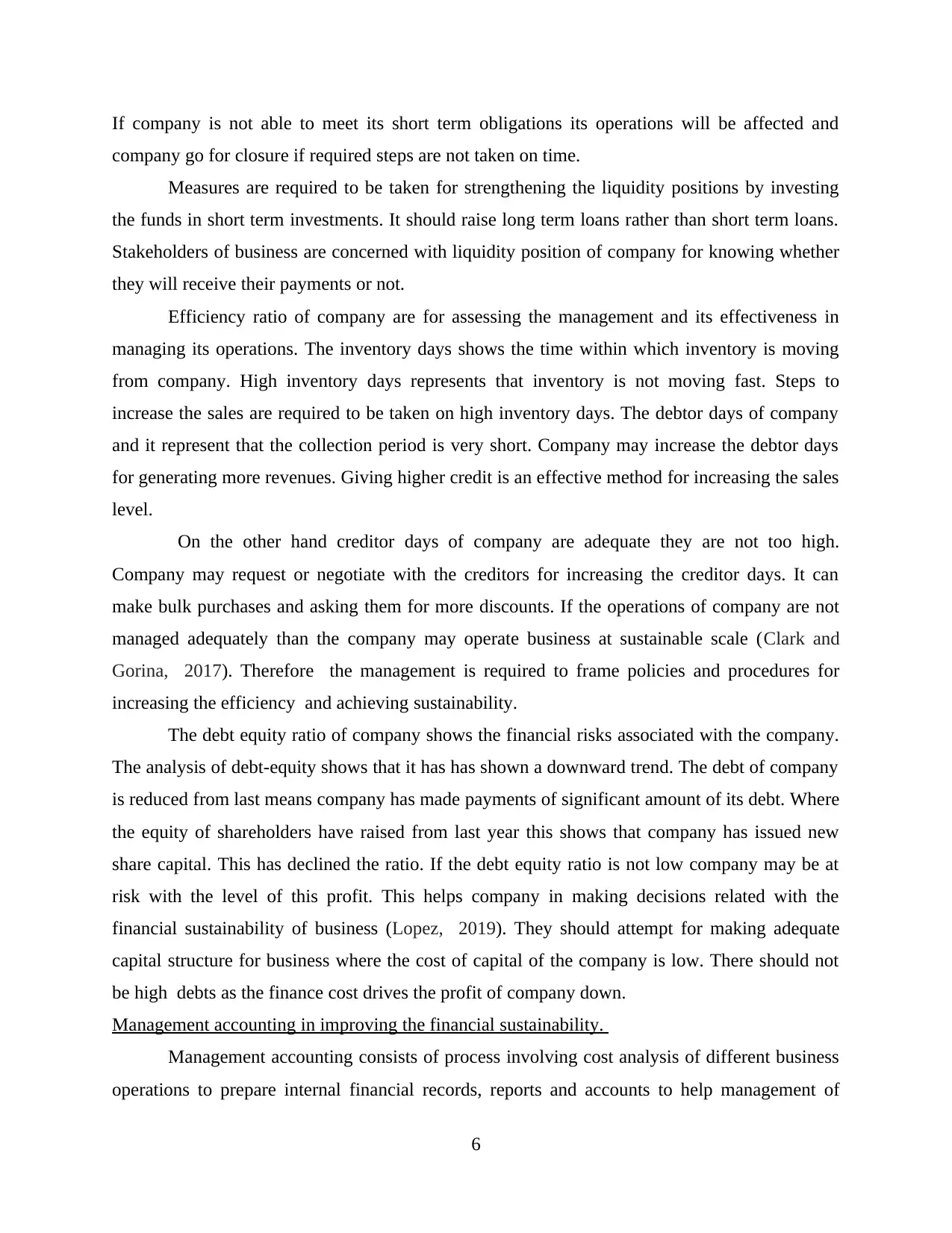
If company is not able to meet its short term obligations its operations will be affected and
company go for closure if required steps are not taken on time.
Measures are required to be taken for strengthening the liquidity positions by investing
the funds in short term investments. It should raise long term loans rather than short term loans.
Stakeholders of business are concerned with liquidity position of company for knowing whether
they will receive their payments or not.
Efficiency ratio of company are for assessing the management and its effectiveness in
managing its operations. The inventory days shows the time within which inventory is moving
from company. High inventory days represents that inventory is not moving fast. Steps to
increase the sales are required to be taken on high inventory days. The debtor days of company
and it represent that the collection period is very short. Company may increase the debtor days
for generating more revenues. Giving higher credit is an effective method for increasing the sales
level.
On the other hand creditor days of company are adequate they are not too high.
Company may request or negotiate with the creditors for increasing the creditor days. It can
make bulk purchases and asking them for more discounts. If the operations of company are not
managed adequately than the company may operate business at sustainable scale (Clark and
Gorina, 2017). Therefore the management is required to frame policies and procedures for
increasing the efficiency and achieving sustainability.
The debt equity ratio of company shows the financial risks associated with the company.
The analysis of debt-equity shows that it has has shown a downward trend. The debt of company
is reduced from last means company has made payments of significant amount of its debt. Where
the equity of shareholders have raised from last year this shows that company has issued new
share capital. This has declined the ratio. If the debt equity ratio is not low company may be at
risk with the level of this profit. This helps company in making decisions related with the
financial sustainability of business (Lopez, 2019). They should attempt for making adequate
capital structure for business where the cost of capital of the company is low. There should not
be high debts as the finance cost drives the profit of company down.
Management accounting in improving the financial sustainability.
Management accounting consists of process involving cost analysis of different business
operations to prepare internal financial records, reports and accounts to help management of
6
company go for closure if required steps are not taken on time.
Measures are required to be taken for strengthening the liquidity positions by investing
the funds in short term investments. It should raise long term loans rather than short term loans.
Stakeholders of business are concerned with liquidity position of company for knowing whether
they will receive their payments or not.
Efficiency ratio of company are for assessing the management and its effectiveness in
managing its operations. The inventory days shows the time within which inventory is moving
from company. High inventory days represents that inventory is not moving fast. Steps to
increase the sales are required to be taken on high inventory days. The debtor days of company
and it represent that the collection period is very short. Company may increase the debtor days
for generating more revenues. Giving higher credit is an effective method for increasing the sales
level.
On the other hand creditor days of company are adequate they are not too high.
Company may request or negotiate with the creditors for increasing the creditor days. It can
make bulk purchases and asking them for more discounts. If the operations of company are not
managed adequately than the company may operate business at sustainable scale (Clark and
Gorina, 2017). Therefore the management is required to frame policies and procedures for
increasing the efficiency and achieving sustainability.
The debt equity ratio of company shows the financial risks associated with the company.
The analysis of debt-equity shows that it has has shown a downward trend. The debt of company
is reduced from last means company has made payments of significant amount of its debt. Where
the equity of shareholders have raised from last year this shows that company has issued new
share capital. This has declined the ratio. If the debt equity ratio is not low company may be at
risk with the level of this profit. This helps company in making decisions related with the
financial sustainability of business (Lopez, 2019). They should attempt for making adequate
capital structure for business where the cost of capital of the company is low. There should not
be high debts as the finance cost drives the profit of company down.
Management accounting in improving the financial sustainability.
Management accounting consists of process involving cost analysis of different business
operations to prepare internal financial records, reports and accounts to help management of
6
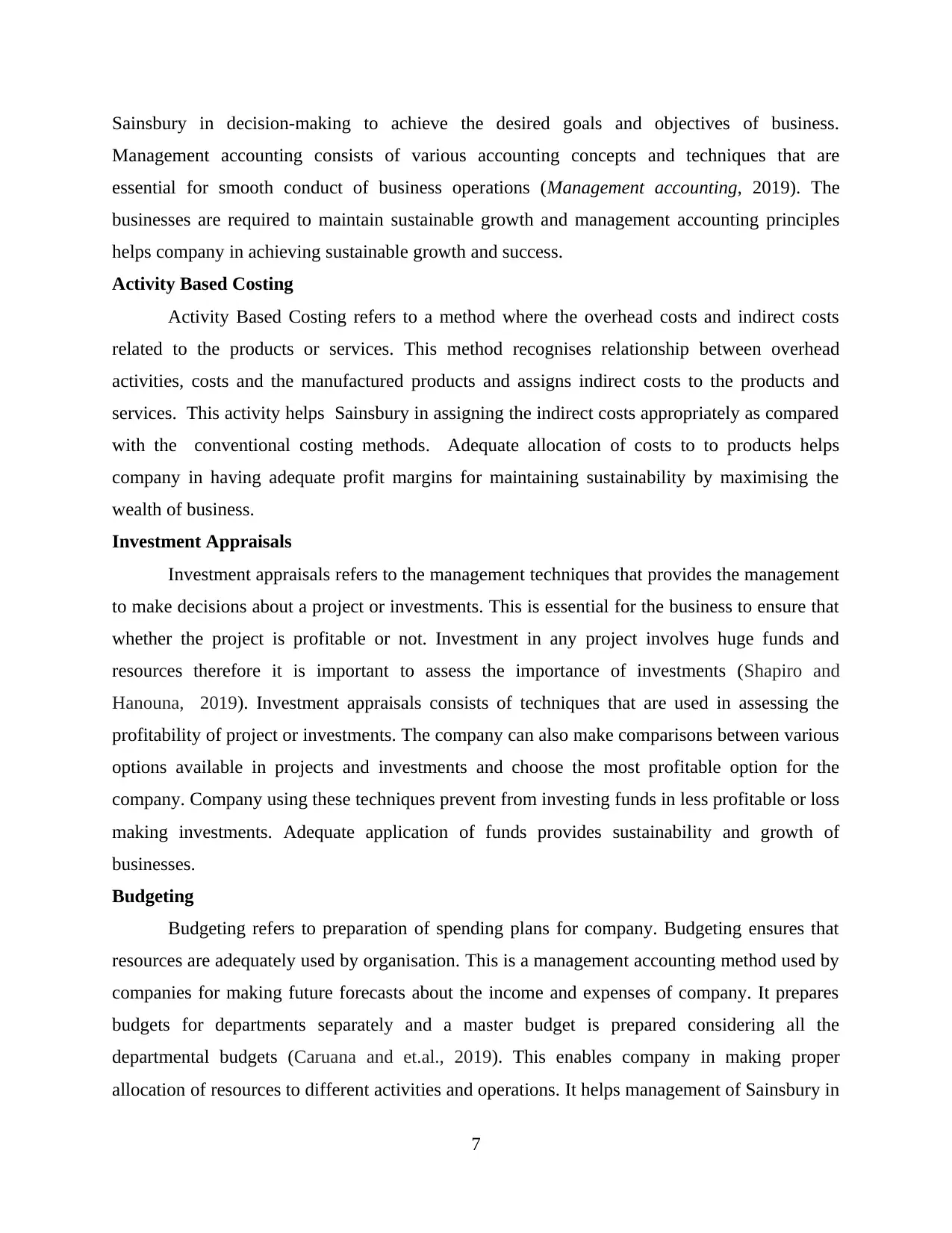
Sainsbury in decision-making to achieve the desired goals and objectives of business.
Management accounting consists of various accounting concepts and techniques that are
essential for smooth conduct of business operations (Management accounting, 2019). The
businesses are required to maintain sustainable growth and management accounting principles
helps company in achieving sustainable growth and success.
Activity Based Costing
Activity Based Costing refers to a method where the overhead costs and indirect costs
related to the products or services. This method recognises relationship between overhead
activities, costs and the manufactured products and assigns indirect costs to the products and
services. This activity helps Sainsbury in assigning the indirect costs appropriately as compared
with the conventional costing methods. Adequate allocation of costs to to products helps
company in having adequate profit margins for maintaining sustainability by maximising the
wealth of business.
Investment Appraisals
Investment appraisals refers to the management techniques that provides the management
to make decisions about a project or investments. This is essential for the business to ensure that
whether the project is profitable or not. Investment in any project involves huge funds and
resources therefore it is important to assess the importance of investments (Shapiro and
Hanouna, 2019). Investment appraisals consists of techniques that are used in assessing the
profitability of project or investments. The company can also make comparisons between various
options available in projects and investments and choose the most profitable option for the
company. Company using these techniques prevent from investing funds in less profitable or loss
making investments. Adequate application of funds provides sustainability and growth of
businesses.
Budgeting
Budgeting refers to preparation of spending plans for company. Budgeting ensures that
resources are adequately used by organisation. This is a management accounting method used by
companies for making future forecasts about the income and expenses of company. It prepares
budgets for departments separately and a master budget is prepared considering all the
departmental budgets (Caruana and et.al., 2019). This enables company in making proper
allocation of resources to different activities and operations. It helps management of Sainsbury in
7
Management accounting consists of various accounting concepts and techniques that are
essential for smooth conduct of business operations (Management accounting, 2019). The
businesses are required to maintain sustainable growth and management accounting principles
helps company in achieving sustainable growth and success.
Activity Based Costing
Activity Based Costing refers to a method where the overhead costs and indirect costs
related to the products or services. This method recognises relationship between overhead
activities, costs and the manufactured products and assigns indirect costs to the products and
services. This activity helps Sainsbury in assigning the indirect costs appropriately as compared
with the conventional costing methods. Adequate allocation of costs to to products helps
company in having adequate profit margins for maintaining sustainability by maximising the
wealth of business.
Investment Appraisals
Investment appraisals refers to the management techniques that provides the management
to make decisions about a project or investments. This is essential for the business to ensure that
whether the project is profitable or not. Investment in any project involves huge funds and
resources therefore it is important to assess the importance of investments (Shapiro and
Hanouna, 2019). Investment appraisals consists of techniques that are used in assessing the
profitability of project or investments. The company can also make comparisons between various
options available in projects and investments and choose the most profitable option for the
company. Company using these techniques prevent from investing funds in less profitable or loss
making investments. Adequate application of funds provides sustainability and growth of
businesses.
Budgeting
Budgeting refers to preparation of spending plans for company. Budgeting ensures that
resources are adequately used by organisation. This is a management accounting method used by
companies for making future forecasts about the income and expenses of company. It prepares
budgets for departments separately and a master budget is prepared considering all the
departmental budgets (Caruana and et.al., 2019). This enables company in making proper
allocation of resources to different activities and operations. It helps management of Sainsbury in
7
⊘ This is a preview!⊘
Do you want full access?
Subscribe today to unlock all pages.

Trusted by 1+ million students worldwide

balancing the expenditures against its revenues. It is essential for the business to ensure that
existing resources are utilised in the best manner generating maximum benefits. Proper spending
plans helps the company to keep its expenditures under control.
CONCLUSION
From the above study it could be concluded that business cannot survive without
adequately managing its financial resources. They are required to manage its financial resources
using appropriate methods and concepts that are essential for the management of the organisation
for making informed decisions. The cost accountant play plays an important role in managing the
financial resources of company. It ensures proper allocation of resources using the methods of
management accounting like budgeting, investment appraisal techniques. They provide the
management with required information for making decisions for the growth and sustainability of
business.
8
existing resources are utilised in the best manner generating maximum benefits. Proper spending
plans helps the company to keep its expenditures under control.
CONCLUSION
From the above study it could be concluded that business cannot survive without
adequately managing its financial resources. They are required to manage its financial resources
using appropriate methods and concepts that are essential for the management of the organisation
for making informed decisions. The cost accountant play plays an important role in managing the
financial resources of company. It ensures proper allocation of resources using the methods of
management accounting like budgeting, investment appraisal techniques. They provide the
management with required information for making decisions for the growth and sustainability of
business.
8
Paraphrase This Document
Need a fresh take? Get an instant paraphrase of this document with our AI Paraphraser
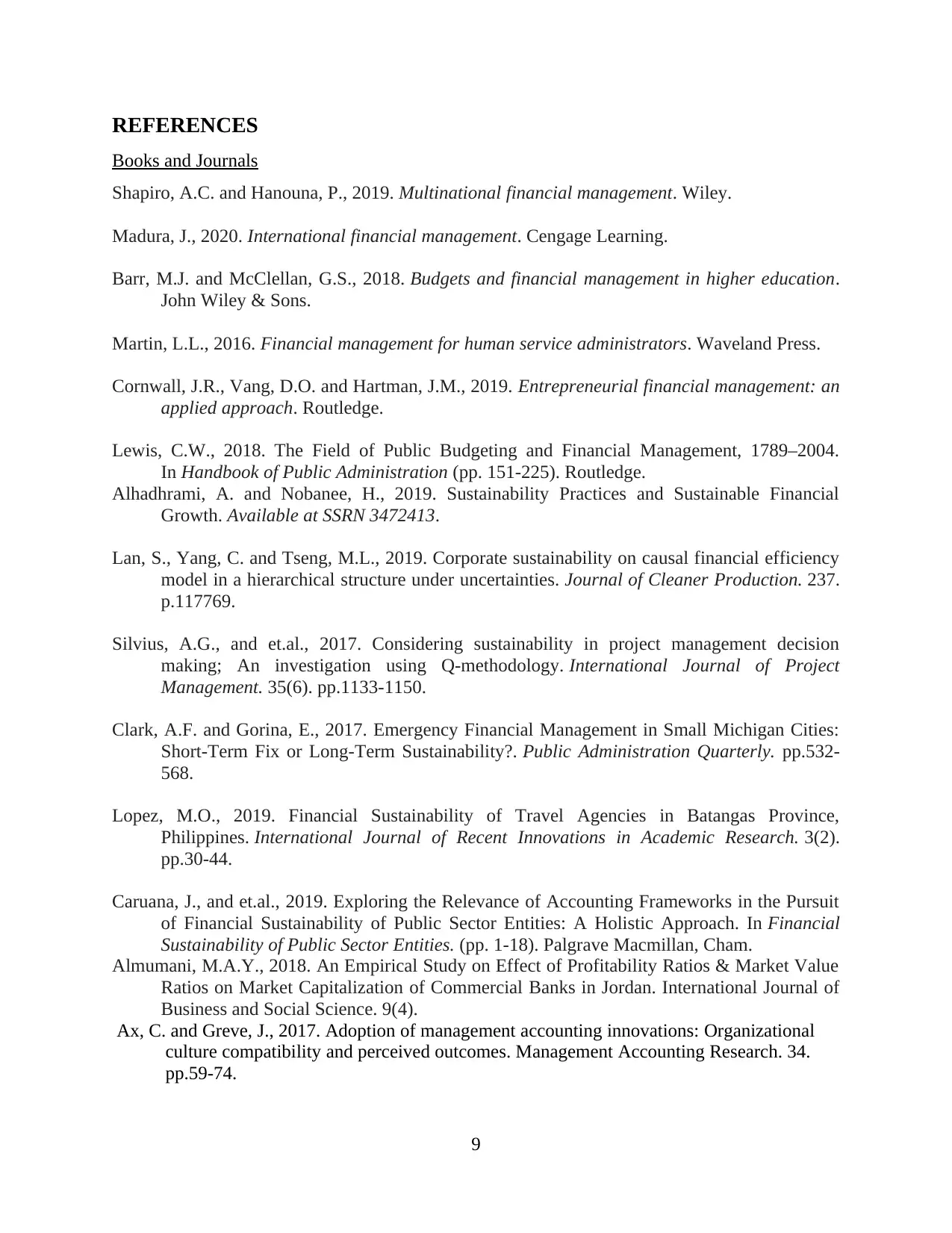
REFERENCES
Books and Journals
Shapiro, A.C. and Hanouna, P., 2019. Multinational financial management. Wiley.
Madura, J., 2020. International financial management. Cengage Learning.
Barr, M.J. and McClellan, G.S., 2018. Budgets and financial management in higher education.
John Wiley & Sons.
Martin, L.L., 2016. Financial management for human service administrators. Waveland Press.
Cornwall, J.R., Vang, D.O. and Hartman, J.M., 2019. Entrepreneurial financial management: an
applied approach. Routledge.
Lewis, C.W., 2018. The Field of Public Budgeting and Financial Management, 1789–2004.
In Handbook of Public Administration (pp. 151-225). Routledge.
Alhadhrami, A. and Nobanee, H., 2019. Sustainability Practices and Sustainable Financial
Growth. Available at SSRN 3472413.
Lan, S., Yang, C. and Tseng, M.L., 2019. Corporate sustainability on causal financial efficiency
model in a hierarchical structure under uncertainties. Journal of Cleaner Production. 237.
p.117769.
Silvius, A.G., and et.al., 2017. Considering sustainability in project management decision
making; An investigation using Q-methodology. International Journal of Project
Management. 35(6). pp.1133-1150.
Clark, A.F. and Gorina, E., 2017. Emergency Financial Management in Small Michigan Cities:
Short-Term Fix or Long-Term Sustainability?. Public Administration Quarterly. pp.532-
568.
Lopez, M.O., 2019. Financial Sustainability of Travel Agencies in Batangas Province,
Philippines. International Journal of Recent Innovations in Academic Research. 3(2).
pp.30-44.
Caruana, J., and et.al., 2019. Exploring the Relevance of Accounting Frameworks in the Pursuit
of Financial Sustainability of Public Sector Entities: A Holistic Approach. In Financial
Sustainability of Public Sector Entities. (pp. 1-18). Palgrave Macmillan, Cham.
Almumani, M.A.Y., 2018. An Empirical Study on Effect of Profitability Ratios & Market Value
Ratios on Market Capitalization of Commercial Banks in Jordan. International Journal of
Business and Social Science. 9(4).
Ax, C. and Greve, J., 2017. Adoption of management accounting innovations: Organizational
culture compatibility and perceived outcomes. Management Accounting Research. 34.
pp.59-74.
9
Books and Journals
Shapiro, A.C. and Hanouna, P., 2019. Multinational financial management. Wiley.
Madura, J., 2020. International financial management. Cengage Learning.
Barr, M.J. and McClellan, G.S., 2018. Budgets and financial management in higher education.
John Wiley & Sons.
Martin, L.L., 2016. Financial management for human service administrators. Waveland Press.
Cornwall, J.R., Vang, D.O. and Hartman, J.M., 2019. Entrepreneurial financial management: an
applied approach. Routledge.
Lewis, C.W., 2018. The Field of Public Budgeting and Financial Management, 1789–2004.
In Handbook of Public Administration (pp. 151-225). Routledge.
Alhadhrami, A. and Nobanee, H., 2019. Sustainability Practices and Sustainable Financial
Growth. Available at SSRN 3472413.
Lan, S., Yang, C. and Tseng, M.L., 2019. Corporate sustainability on causal financial efficiency
model in a hierarchical structure under uncertainties. Journal of Cleaner Production. 237.
p.117769.
Silvius, A.G., and et.al., 2017. Considering sustainability in project management decision
making; An investigation using Q-methodology. International Journal of Project
Management. 35(6). pp.1133-1150.
Clark, A.F. and Gorina, E., 2017. Emergency Financial Management in Small Michigan Cities:
Short-Term Fix or Long-Term Sustainability?. Public Administration Quarterly. pp.532-
568.
Lopez, M.O., 2019. Financial Sustainability of Travel Agencies in Batangas Province,
Philippines. International Journal of Recent Innovations in Academic Research. 3(2).
pp.30-44.
Caruana, J., and et.al., 2019. Exploring the Relevance of Accounting Frameworks in the Pursuit
of Financial Sustainability of Public Sector Entities: A Holistic Approach. In Financial
Sustainability of Public Sector Entities. (pp. 1-18). Palgrave Macmillan, Cham.
Almumani, M.A.Y., 2018. An Empirical Study on Effect of Profitability Ratios & Market Value
Ratios on Market Capitalization of Commercial Banks in Jordan. International Journal of
Business and Social Science. 9(4).
Ax, C. and Greve, J., 2017. Adoption of management accounting innovations: Organizational
culture compatibility and perceived outcomes. Management Accounting Research. 34.
pp.59-74.
9
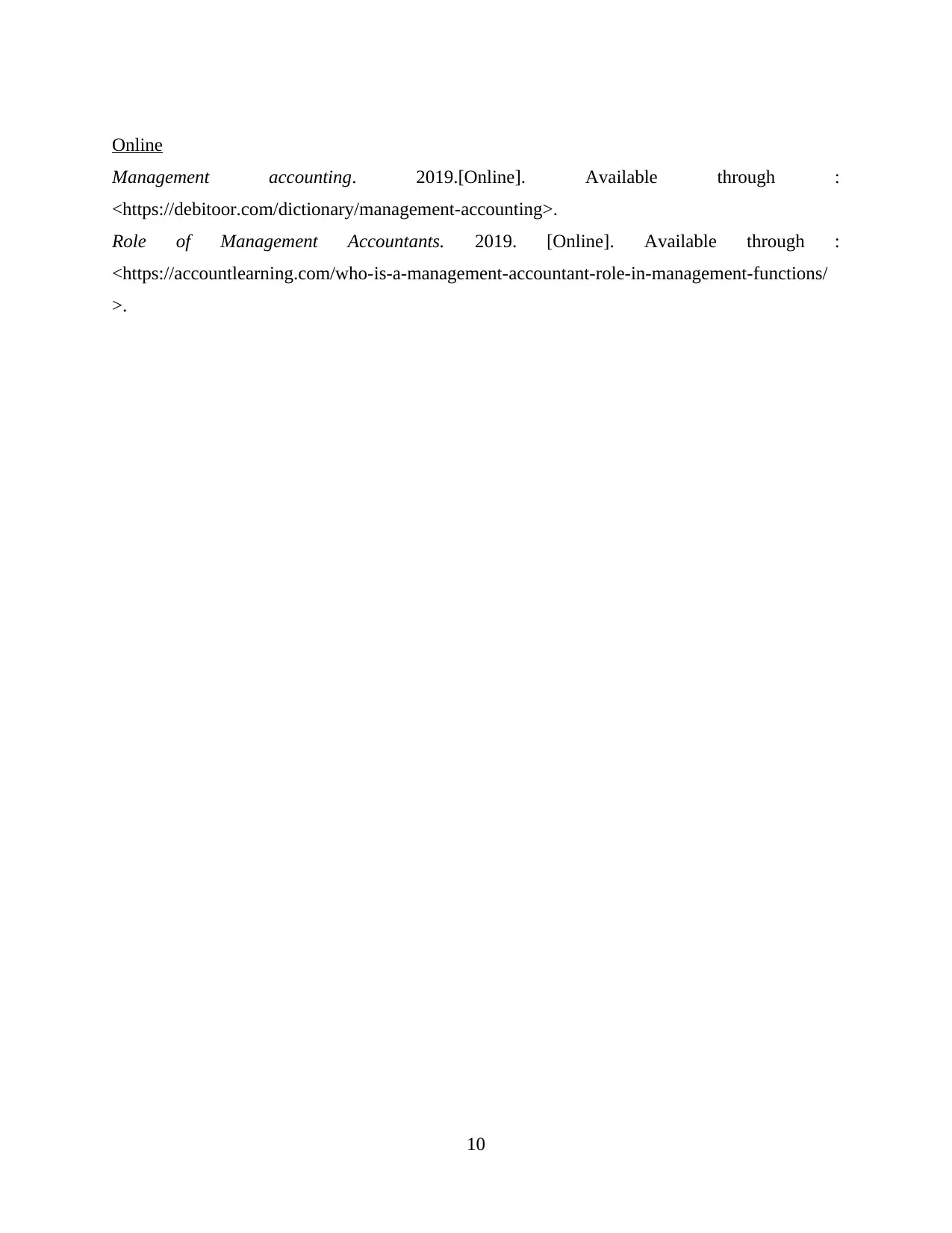
Online
Management accounting. 2019.[Online]. Available through :
<https://debitoor.com/dictionary/management-accounting>.
Role of Management Accountants. 2019. [Online]. Available through :
<https://accountlearning.com/who-is-a-management-accountant-role-in-management-functions/
>.
10
Management accounting. 2019.[Online]. Available through :
<https://debitoor.com/dictionary/management-accounting>.
Role of Management Accountants. 2019. [Online]. Available through :
<https://accountlearning.com/who-is-a-management-accountant-role-in-management-functions/
>.
10
⊘ This is a preview!⊘
Do you want full access?
Subscribe today to unlock all pages.

Trusted by 1+ million students worldwide
1 out of 12
Related Documents
Your All-in-One AI-Powered Toolkit for Academic Success.
+13062052269
info@desklib.com
Available 24*7 on WhatsApp / Email
![[object Object]](/_next/static/media/star-bottom.7253800d.svg)
Unlock your academic potential
Copyright © 2020–2025 A2Z Services. All Rights Reserved. Developed and managed by ZUCOL.





